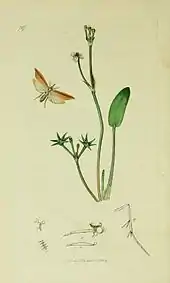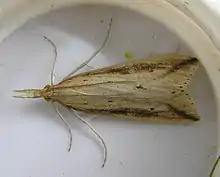Donacaula forficella
Donacaula forficella is a species of moth of the family Crambidae described by Carl Peter Thunberg in 1794. It is found in China (Heilongjiang),[1] Europe and South Africa.[2]

Illustration from John Curtis's British Entomology Volume 6
| Donacaula forficella | |
|---|---|
 | |
| Male | |
| Scientific classification | |
| Domain: | Eukaryota |
| Kingdom: | Animalia |
| Phylum: | Arthropoda |
| Class: | Insecta |
| Order: | Lepidoptera |
| Family: | Crambidae |
| Genus: | Donacaula |
| Species: | D. forficella |
| Binomial name | |
| Donacaula forficella (Thunberg, 1794) | |
| Synonyms | |
| |
The wingspan is 25–30 mm. The forewings are yellow with a fuscous band along the upper margin of the cell and a fuscous spot at the lower angle of the cell. The moth flies from May to September depending on the location.
The larvae feed on Carex, Glyceria maxima and Phragmites.
References
- Chen, Fu-Qiang; Wu, Chun-Sheng (April 2014). "Taxonomic review of the subfamily Schoenobiinae (Lepidoptera: Pyraloidea: Crambidae) from China". Zoological Systematics. 39 (2): 163–208. doi:10.11865/zs20140201. Archived from the original on July 2, 2014.
- De Prins, J. & De Prins, W. (2017). "Donacaula forficella (Thunberg, 1794)". Afromoths. Retrieved March 1, 2018.
Wikispecies has information related to Donacaula forficella.
Wikimedia Commons has media related to Donacaula forficella.
This article is issued from Wikipedia. The text is licensed under Creative Commons - Attribution - Sharealike. Additional terms may apply for the media files.